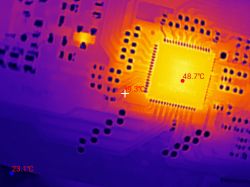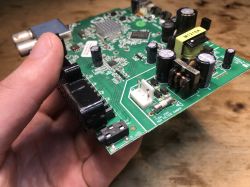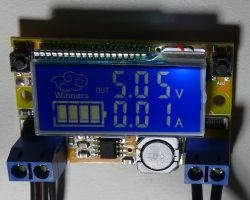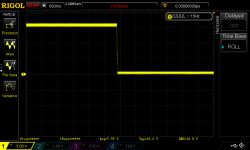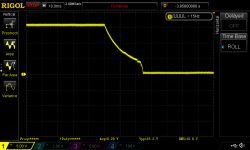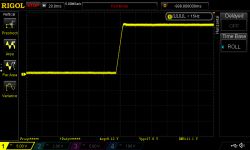FAQ
TL;DR: Bench tests show up to 1.5 Vpp ripple at 5 V/1 A (30 %)—“a massacre” [Elektroda, czareqpl, post #17122326] A simple 470 µF output cap cuts noise dramatically [Elektroda, mkpl, post #17125841] Module uses the MP2307 ‘mini-360’ buck core rated 23 V / 3 A [Elektroda, mkpl, post #17125841]
Why it matters: Knowing limits and fixes lets makers avoid burnt loads and noisy measurements.
Quick Facts
• Input range: 6 – 23 V (20 V recommended) [Elektroda, TechEkspert, post #17120828]
• Adjustable output: 0 – 16.3 V, 2 A continuous, 3 A short-term [Elektroda, TechEkspert, post #17120828]
• Measured ripple: 150 mVpp no-load, 1.5 Vpp at 1 A [Elektroda, czareqpl, post #17122326]
• Price tag in PL: ~36 PLN incl. plexi case [Elektroda, fred114, post #17121821]
• Controller IC: MP2307 320 kHz synchronous buck (‘mini360’) [Elektroda, mkpl, post #17125841]
Where can I buy the LCD 2 A buck module?
Sellers list the board as “LCD DC/DC buck 2A plexi case”. Search on AliExpress or eBay or use the Gotronik offer at about 36 PLN [Elektroda, fred114, #17121821; Elektroda, hehehehuhuhu, #17121843].
Which chip drives the converter?
The power stage is the MP2307 synchronous buck IC, commonly sold as the “mini-360” module, rated 23 V in, 3 A peak, 320 kHz switching [Elektroda, mkpl, post #17125841]
Why does the display show a battery icon?
The battery indicator is cosmetic. Firmware leaves the segments static under all conditions, so it conveys no real information [Elektroda, TechEkspert, post #17123195]
How bad is the output ripple?
Scope captures show 150 mVpp with no load and 1.5 Vpp at 5 V, 1 A—equal to 30 % of nominal voltage [Elektroda, czareqpl, post #17122326]
Can I reduce that ripple?
Yes. Replacing the tiny MLCCs with one 470 µF low-ESR cap (e.g., Panasonic NXH) cuts ripple sharply. Larger caps may help further, limited by ripple current rating [Elektroda, mkpl, post #17125841]
Quick 3-step fix for cleaner output?
- Desolder the two 22 µF 1206 MLCCs at Vout.
- Solder a 470 µF/16 V low-ESR electrolytic directly across Vout and GND.
- Retest ripple; expect >5× reduction [Elektroda, mkpl, post #17125841]
Is there any current limiting?
No active current limit exists. Exceeding 2 A or shorting the output can smoke the board, as several users observed [Elektroda, Urgon, post #17121867]
Why do users complain about the screw terminals?
Factory terminals have high contact resistance and weak solder joints. Wires detach after a few insertions; many users bypass them and solder leads directly [Elektroda, Urgon, post #17123318]
What happens if input power vanishes while Vout is set high?
With Vin=20 V and Vout=15 V, loss of input produces a smooth decay; no reverse boost was seen [Elektroda, TechEkspert, post #17168528] The 47 µF output cap emptied in ~3 ms [Elektroda, wieswas, post #17169776]
Safe to hang a large capacitor or battery on the output?
A large 4,700 µF cap or battery will back-drive the buck through the MP2307’s body diode. Add a series Schottky or MOSFET ideal-diode to block reverse current [Elektroda, wieswas, #17168746; MP2307 datasheet].
What input voltage should I really use?
Keep Vin ≤ 20 V. The MP2307’s absolute max is 23 V, but users report failures near that limit [Elektroda, TechEkspert, #17120828; Elektroda, mkpl, #17125841].
Can I recalibrate the voltage display?
Yes. Calibration constants live in the on-board STM8 firmware; a hidden menu allows trimming the reading without hardware mods [Elektroda, TechEkspert, post #17126256]
Edge-case: will it power a Raspberry Pi reliably?
Tests with a similar LCD-less version caused Pi brown-outs and lightning-bolt icons despite 5 A rating, due to ripple and dropouts [Elektroda, nici, post #17124228]
Any better alternatives?
If you need 0–30 V and real current limit, consider the 9 A/300 W buck module discussed in a parallel thread [Elektroda, brofran, post #17123051]



